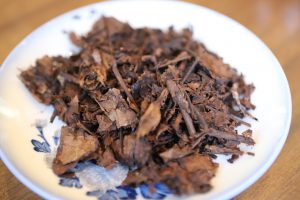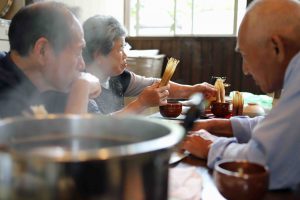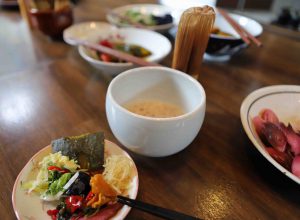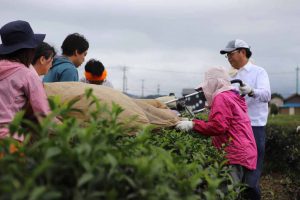MENU
MENU
Tea production area: Asahi Town
Brand name of tea: Batabata-cha (Batabata tea)
Type of tea: Dark tea (post-fermentation tea)
Batabata tea for the Buddha and maintaining the community
Batabata tea, which is a post-fermented tea (dark tea), has been drunk since long ago in Birudani, Asahi Town. Tradition says that Batabata tea was introduced from China, and when a Buddhist monk Rennyo, the eighth chief priest of Jodo Shinshu preached in 1472, Batabata tea was offered to the Buddha.

Batabata tea in the Batabata tea heritage museum (September 2018)
Batabata tea maintains the local community
It was customary to have Batabata tea with neighbors around the fireplace when having a Buddhist service, celebrating a wedding or a childbirth. Having Batabata tea has helped with maintaining local community in Birudani, Asahi Town.

Batabata-cha in the Batabata tea heritage museum (September 2018)
How to drink Batabata tea
Put Batabta tea leaves in a cotton bag and boil it with ample hot water in a large pot. Serve the first cup to the Buddha. Pour Batabata tea in a dedicated bowl called Goromaru chawan (五郎丸茶碗). Goromaru chawan is slightly smaller than a matcha chawan (matcha bowl). Whisk the tea with a dedicated chasen (茶筅). One set of chasen is two long chasen attached together. Move the chasen from side to side to whisk the tea. Add a pinch of salt if desired. Drink Batabata tea while chatting with neighbors and leisurely eating handmade dishes such as pickles or cooked vegetables.
Batabata tea has a taste similar to Pu’er tea, with cinnamon and mint flavors (it is a personal opinion of the author of this article).
Batabata tea heritage museum バタバタ茶伝承館
There is a Batabata tea heritage museum in Asahi Town. Local people and visitors from other areas can visit the museum to drink Batabata tea and eat handmade dishes when the museum is open.

Batabata tea and dish made by local people
in the Batabata tea heritage museum (September 2018)
Inherited Batabata tea
Due to the aging and the shortage of successors, the number of tea producers has decreased. The members of Asahi Town Shokokai (chamber of commerce) cultivate tea and produce Batabata tea at the Batabata tea heritage museum once a year in July or August, the hottest season.

Members of Asahi shokokai plucking tea leaves (September 2018)
に入れる1-300x200.jpg)
Putting steamed tea leaves into a wooden container called muro in the Batabata heritage museum (September 2019)
*In 2019 the picking and production of Batabata tea were implemented in July and September due to the weather.
Batabata tea is drank in Wakasa Town, Fukui Prefecture, Kosugi Town, Toyama Prefecture, and Itoigawa area, Nigata Prefecture. Batabata tea of Itoigawa Area uses bancha, not post-fermentation tea.
How to make Batabata tea
1. Pluck tea leaves at the end of July or the beginning of August.
2. Remove branches and cut tea leaves into small pieces.
3. Steam tea leaves.
4. Roll the steamed tea leaves by hand
5. Put the tea leaves into a wooden container called Muro and put a wooden lid on the container.
6. Ferment the tea leaves aerobically for 40 days. Mix the tea leaves once every few days for a total of about 10 times in order to maintain a consistent temperature of the container, not over 65 degrees Celsius during the fermentation period.
7. At the beginning of September, dry the tea leaves in the shade for half a day, then dry them in the sun for a few days.
Related article on the site: 「日本のお茶の生産状況」「お茶の種類 バタバタ茶」
Tea related facility:
Batabata tea heritage museum バタバタ茶伝承館 https://www.asahi-tabi.com/asahimachi/262/
なないろKAN https://www.asahimachi.com/nanairo/
朝日町歴史公園 https://www.asahi-tabi.com/asahimachi/249/
Ceramic and pottery art: Ecchu-seto ware
Reference:
バタバタ茶伝承館のバタバタ茶の説明パネル
松下智 (平成3年) 日本名茶紀行 (初版) 雄山閣出版
大森正司、阿南豊正、伊勢村護、加藤みゆき、滝口明子、中村羊一郎編(2017) 茶の事典 初版第一刷 朝倉書店
*When visiting the shops and facilities introduced in this article, please check the business hours on their website, etc. before visiting.
*The information provided on this site may be updated. If you find any information in this article that is incorrect, new, or incomplete, please contact CHAMART.
*The site does not describe all “Teas of Japan” or all “Teas of the World”. Additionally, each article expresses the writer’s personal experience and feelings.
#toyama #batabatacha #batabatatea